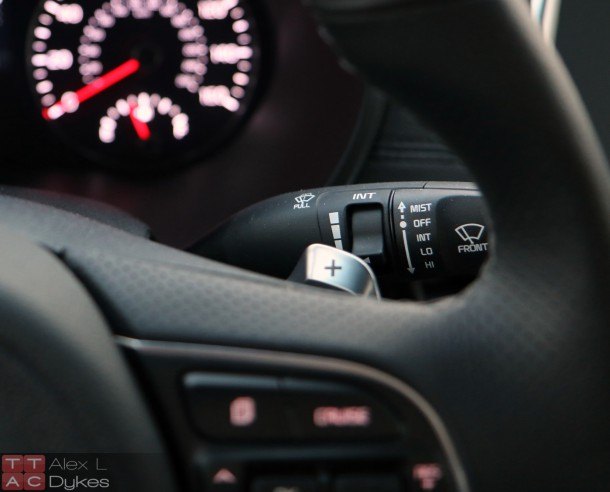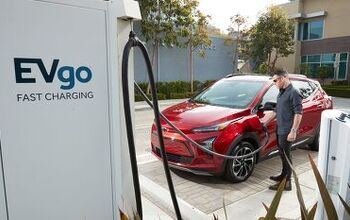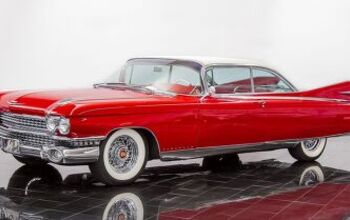2016 Kia Optima SXL Review - Short Road to the Top (Video)

2016 Kia Optima SXL
It’s easy to see why some automakers resist putting premium features in mass market models. All you need to do is look at that luxury showroom to the right. In the quest to differentiate, say, the Ford Fusion from its Lincoln counterpart, or the Toyota Avalon from the Lexus ES, and so forth, manufacturers limit the options and luxuries available on the more pedestrian models.
On the surface, the Optima SXL’s mission could be confused with that of competitors from other non-luxury marques — Accord Touring and Fusion Titanium to name two — but Kia takes its top-trim game a couple steps further. You see, Kia is in a different position as the Optima has no luxury branded sistership and Kia has nothing to lose by creating an Optima trim that could arguably compete with the Acura TLX and Lincoln MKZ.
However, the Optima SXL’s existence does give rise to a very important question: Can a gussied-up family sedan be a value alternative to a near-luxury option, such as the TLX or MKZ? Or is this a case of “making a silk purse out of a sow’s ear?”
Let’s find out.
You may be surprised to find the 2016 Optima is a nearly complete redesign despite it being only four years old. Why did Kia bother redesigning a model that was selling so well? More importantly, how can Kia afford such a substantial redesign after just four years? Well, first you need to understand the relationship between Hyundai and Kia.
Hyundai bought 51 percent of Kia back in 1998 and — although they have reduced their stake over the years — Kia and Hyundai are closely tied when it comes to research and development.
Thankfully, this isn’t GM-style badge engineering circa 1980.
The process goes like this: A communal team designs the engines, transmissions, hybrid systems, suspension components, safety systems, etc. Then, Hyundai and Kia pull from their respective design bins and craft a vehicle around those same building blocks. This means that while the Optima and Sonata are virtually identical mechanically, almost nothing you see and touch is shared. The extra sales volume using these building blocks has allowed Kia to improve their game at a lightning pace. It would be hard for Mazda or Subaru to justify a complete redesign of their family sedans after only five years on sale. But when you combine Optima and Sonata sales together, they beat Accord year-to-date and come second only to Camry.
Exterior
The new sheetmetal looks more grown up. Kia’s signature “tiger nose” grille has been blended with the headlamps, giving the front a wider appearance. The rear end has been made more expressive with optional LED taillamps and a spoiler.
As seen in most of its competitors, exterior tweaks differentiate the five different trim levels. Moving from the base LX model to the mid-grade EX gets you new headlamps, tail lamps and a different grille. Jumping up to the top-end trim replaces the grille (again), swaps its front and rear bumper covers for those with a sportier look, and adds dual exhaust tips and an aero-look rear lower valance.
Interior
Gone is the Saab-esque interior design, replaced with a more symmetrical center stack no longer tilted toward the driver. The overall design is fairly upright compared to the sloping dashes we see in some competing vehicles.
As we see in other Kia models, the overall parts quality increases as you climb up the model ladder. But, unlike the others in this segment, major components are also swapped as you move up to the top trims. Instead of just swapping cloth and leather inserts, the SXL uses different dashboard and door components featuring stitched leatherette to imitate the popular stitched leather dashes on luxury cars. The overall effect is more impressive than what’s found in Buick and Lexus models where a standard injection molded part is “after stitched” to give the impression of stitched materials. The SXL also gains nappa leather seating and rear window shades.
Driver’s seat comfort varies by model, but all are notably above average for the segment. Base models get an eight-way seat with two-way adjustable lumbar support — something skipped by many of competition. In an unexpected move, the $24,890 EX model gains a 12-way power seat with four-way lumbar. The passenger seat has a more limited range of motion, but you can option your way into a power passenger seat with two-way lumbar. EX trims and above feature a standard heated steering wheel, a rarity even on $100,000 luxury cars.
Hop in the back and you’ll notice the legroom is generous, but the coupé-like profile comes at the expense of headroom. While the Optima is not as limited as the 200 or Fusion for my six-foot frame, it’s still bested by the Accord and Camry.
Kia up-sized the trunk for 2016 to 15.9 cubic feet, which makes this one of the larger boots in the biz. Pulling a trick out of Nissan’s playbook, Kia allows you to put 24-inch roller bags in the upright position at the edge of the trunk and still close the lid.
Infotainment
Kia’s starter infotainment system features a 5-inch color LCD, backup camera, six speakers, CD player, iPod interface, Bluetooth and satellite radio standard.
The next step up is Kia’s 8-inch UVO system with eServices and navigation. This infotainment option can be added to EX trims as part of a $3,700 bundle that includes a panoramic roof, power passenger seat, ventilated front seats, blind spot monitoring, cross traffic detection, rear parking sensors and a dimming rear mirror. New for 2016 is the ability to monitor your teen with geo-fencing, speed alerts and driver scoring. Once you have that option box checked, you can tack on $1,200 for the 630-watt, 10-speaker Harman/Kardon Logic7 audio system, similar to the mid-level system in many BMW models.
Kia says that Apple CarPlay and Android Auto will be available soon on models with the 8-inch screen via a software update. However, the only way to get that screen in 2016 is to get the package that also includes navigation, which makes CarPlay a little less impressive.
Our SXL model had yet more luxury gadgets and goodies brought down from the K900, including a 360-degree camera system a la Infiniti, full speed range adaptive radar cruise control, forward collision warning and auto brake hold.
Drivetrain
New for 2016 is a 1.6-liter turbocharged four-cylinder engine in the new LX 1.6T trim. Thanks to the turbo, the engine cranks out a little less power than the 2.4 (178 horsepower) but more torque across a wider rev range (195 lbs-ft from 1,500 to 4,500 rpm). Sending power to the wheels is a snazzy new 7-speed dual-dry-clutch unit that will soon arrive in the 2017 Sportage.
SX and SXL trims use Kia’s new 2-liter four-cylinder turbo rated at 245 horsepower at 6,000 rpm and 260 lbs-ft from 1,350 to 4,500 rpm. Like the 2.4-liter engine, the 2-liter turbo is solely mated to a six-speed automatic. It’s worth noting that the Optima doesn’t need to run on premium gasoline to achieve its rated power output, unlike the 2-liter Ecoboost engine in the Fusion.
Fuel economy isn’t the Kia’s Forte. (See what I did there?) The popular 2.4-liter engine scored an EPA combined rating of between 28 and 30 mpg depending on trim, and in real-world driving there’s a 4-5 mpg difference between the Optima and the CVT-equipped options in this segment. If you want that kind of fuel economy, you’ll need to get the LX 1.6T. Meanwhile, our SXL model came in at 25 mpg combined, similar to its V-6 competition.
Pricing and Value
In addition to perforated leather seats, you’ll also get power folding side mirrors, two-zone auto climate control, heated seats, heated steering wheel, LED tail lamps, keyless start, driver’s seat/mirror memory system, projector headlamps, a tweaked grille and auto up/down front windows. That list of features makes the Optima 18-percent less expensive ($3,700) than an Accord EX-L despite the Kia offering an additional $1,000 worth of content. Even the Chrysler 200 and Ford Fusion will be at least $1,500 more when comparably equipped.
But we’re here to talk about the luxury Optimas.
Think of the SX as the “base” luxury trim. It gets much of the same interior and exterior differentiation for $26,690 and you can add options until you get near the SXL’s $35,790 price tag.
The SXL can be thought of as a fully loaded SX with a bit more icing on the cake. This is where you’ll find radar adaptive cruise control, a panoramic roof, rear window shades, nappa leather, ventilated seats, auto brake hold, xenon headlamps that steer, auto high beams, a 360-degree surround view camera, 18-inch wheels, shift paddles, alloy pedals, the snazzy speaker system, and upgraded dashboard and door parts. That puts the Optima SXL on the same footing feature-wise as an Acura TLX V-6 with the Advance Package. The Optima isn’t as fast as the Acura, but it has a longer warranty and is nearly $7,000 less expensive. Adjusting for feature content reveals the TLX and Optima are well matched as each offers equipment not found on the other, so feature content adjustment ends up right at zero.
It’s a similar story when you compare the current Lincoln MKZ with the Optima.
Drive
Also setting the upper trims apart is a revised suspension and wider 235-width tires. This, combined with the relatively light 3,219-3,362 pound curb weight, allows the Optima to hold its own when compared with the Accord Sport, Fusion Titanium and the front-wheel-drive Acura TLX.
Unlike the last Optima that could get upset on corners with broken pavement, the new sedan is almost Germanic in its stability while still delivering a moderately plush ride. I’d be interested to see a sport variant with 245-width summer tires. Thanks to a sound deadening windshield in all models and sound control side glass in EX, SX and SXL, the Optima is one of the quietest sedans on sale today.
Kia’s 2.4-liter engine lags the competition when it comes to fuel economy, but the 2.0-liter turbo is a different animal. I finished the week with an average of 25.2 mpg, coming in at 4 mpg better than we got in the last 2.0-liter Ecoboost Fusion. If you want more fuel economy, the upcoming Optima Hybrid is likely to match the 41 mpg average we recently scored in the 2016 Sonata Hybrid.
Although Kia’s 2-liter turbo engine is down 29 horsepower vs the last generation engine, you’re unlikely to notice the difference. Our 0-60 test resulted in a sprightly 5.9 second sprint, essentially the same as the last turbo Optima. Where things are different is the way the power is delivered. By swapping in a different turbo, Hyundai/Kia engineers were able to broaden the torque range by 300 rpm and the fall-offs aren’t nearly as abrupt. This means the transmission doesn’t have to hunt through the gears as much in daily or mountain driving.
The Optima came just a few weeks after the 2016 Accord — a good thing for Kia, less so for Honda. The Accord is the sensible orthopedic while the Optima is a trendier cross-trainer. Honda’s focus is obviously on fuel economy and a child-friendly back seat. The Optima has a split mission. The EX is hands down the best value in this segment while the SXL is a novel twist on the family sedan. Kia swaps out enough parts that if you didn’t know the lower trims existed, you’d think the Optima was designed to be a value alternative to the MKZ and TLX. There are a few hard plastics to be found, but the level of “polish” the Optima possess was unexpected. The radar adaptive cruise control system is smoother in operation than that found in the Lincoln MKZ (and miles ahead of Acura), the leather is supple, the interior design is pleasing and CarPlay and Android Auto are entertaining novelties. The Kia is also $6,000 less while delivering a longer warranty. It won’t sell in large numbers, but Kia probably doesn’t care as the Optima SXL was likely millions less to design than the Acura TLX or Lincoln MKZ.
Without luxury marques to worry about, Kia was free to step on the toes of “near luxury” and the result is a more harmonious interior than that found in the Fusion, Accord or Camry. Even though the Optima SXL is $1,000 more than an Accord Touring and $2,000 more than a Camry V-6, the Kia’s interior is worth the difference.
Ponder that statement.
Would you have thought 20 years ago that Kia could make an interior worth $2,000 more than a comparable Toyota?
Perhaps it is possible to make a silk purse out of a sow’s ear.
Kia provided the vehicle, insurance and one tank of gas for this review
Specifications as tested
0-30 mph: 2.4 seconds
0-60 mph: 5.9 seconds
1/4 Mile: 14.2 Seconds @ 98 mph

More by Alex L. Dykes
Latest Car Reviews
Read moreLatest Product Reviews
Read moreRecent Comments
- Dwford Will we ever actually have autonomous vehicles? Right now we have limited consumer grade systems that require constant human attention, or we have commercial grade systems that still rely on remote operators and teams of chase vehicles. Aside from Tesla's FSD, all these systems work only in certain cities or highway routes. A common problem still remains: the system's ability to see and react correctly to obstacles. Until that is solved, count me out. Yes, I could also react incorrectly, but at least the is me taking my fate into my own hands, instead of me screaming in terror as the autonomous vehicles rams me into a parked semi
- Sayahh I do not know how my car will respond to the trolley problem, but I will be held liable whatever it chooses to do or not do. When technology has reached Star Trek's Data's level of intelligence, I will trust it, so long as it has a moral/ethic/empathy chip/subroutine; I would not trust his brother Lore driving/controlling my car. Until then, I will drive it myself until I no longer can, at which time I will call a friend, a cab or a ride-share service.
- Daniel J Cx-5 lol. It's why we have one. I love hybrids but the engine in the RAV4 is just loud and obnoxious when it fires up.
- Oberkanone CX-5 diesel.
- Oberkanone Autonomous cars are afraid of us.












































































Comments
Join the conversation
That 6 banger engine cover on a 4 pot though. So wrong, because only those who know will care and those who care will know.
I've read 4 reviews on this vehicle and two hate it, one is neutral, and this one loves it. Interesting the variance of opinions by automotive journalists.